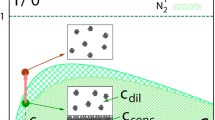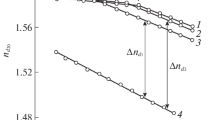Summary
A statistical consideration is presented on the solution state of a polysoap molecule, in which soap-like groups are situated with a definite interval along the long backbone of a polymer. Under the assumption that the association of soap-like groups occurs only between neighboring groups, two parameters s and σ have been introduced. The former parameter s is the statistical weight to be given for the incorporating of a soap-like group into an aggregate of soap-like groups (an intramolecular micelle) that is already formed, while σ s is the weight for combining two non-associated soap-like groups into an aggregate. In typical polysoaps, the following three conditions are postulated.
-
1.
s larger than unity, but not extremely large.
-
2.
σ smaller than unity.
-
3.
fairly large number of soap-like groups n.
Several important features concerning the intra-molecular micellization have been discussed from the partition function which is expressed by a matrix formula of s, σ, and n.
-
1.
Transition from monosoap to polysoap. If the polymerization degree of a polysoap is increased from one to infinity, the average number of soap-like groups in a intramolecular micelle increases asymptotically from unity to a certain finite value. This indicates that intramolecular micelles generate even in an infinitely dilute solution of a polysoap.
-
2.
Transition from polyelectrolyte to polysoap. If s is increased over unity (s < 1 → s > 1), the intra-molecular micellization becomes noticeable and the molecular form contracts. This is achieved either by increasing the hydrocarbon length of the soap-like group, or by decreasing the distance between neighboring soap-like groups.
-
3.
The soap-like groups situated near the ends of the polymer chain have a weaker tendency to aggregate compared with those situated at the middle of the chain.
Zusammenfassung
Eine statistische Betrachtung über den Lösungszustand eines polymeren Seifenmoleküls, in dem die seifenähnlichen Gruppen mit definiertem Intervall längs des Kettengerüsts des Polymeren angeordnet sind, wird vorgelegt. Unter der Annahme, daß die Assoziation der Seifengruppen nur zwischen benachbarten Gruppen auftritt, werden zwei Parameter s und σ eingeführt. Der erstere ist das statistische Gewicht, das für die Überführung einer Seifengruppe in ein Aggregat von solchen, in eine intramolekulare Mizelle, die schon geformt ist, gegeben ist, während σ s das Gewicht für die Kombination zweier noch nicht assoziierter Seifengruppen zu einem Aggregat zukommt. In typischen polymeren Seifen werden folgende drei Bedingungen postuliert:
-
1.
s ist größer als 1, aber nicht extrem groß.
-
2.
σ ist kleiner als 1 und
-
3.
Es besteht eine genügend große Anzahl n von Seifengruppen.
Einige wichtige Folgerungen über intramolekulare Mizellbildung werden aus der Verteilungsfunktion, ausgedrückt durch eine Matrixformel von s, σ und n, diskutiert.
-
1.
Der Übergang von Monoseife zu Polyseife: Wenn der Polymerisationsgrad einer Seife von 1 zu unendlich wächst, so wächst die mittlere Zahl von Seifengruppen in einer intramolekularen Mizelle asymptotisch von 1 zu einem gewissen endlichen Wert. Das zeigt, daß intramolekulare Mizellen auch in unendlich verdünnten Lösungen von Polyseifen existieren.
-
2.
Übergang von Polyelektrolyt zu Polyseife: Wenn s von Werten kleiner 1 zu solchen größer 1 vermehrt wird, wird die intramolekulare Mizellbildung beträchtlich, und die Molekülform kontrahiert sich. Dies kann entweder durch Vergrößerung der Länge der Kohlenwasserstoffkette in der Seifengruppe oder durch Abnahme des Abstandes zwischen benachbarten Seifengruppen geschehen.
-
3.
Die Seifengruppen in der Nähe der Enden der Polymerketten besitzen eine geringere Assoziations-tendenz, verglichen mit den an der Mitte der Kette sitzenden.
Similar content being viewed by others
References
Strauss, U. P. andN. L. Gershfeld, J. Phys. Chem.58, 747 (1954).
Strauss, U. P., N. L. Gershfeld and,E. H. Crook; J. Phys. Chem.60, 577 (1956).
Strauss, U. P. andB. L. Williams, J. Phys. Chem.65, 1390 (1961).
Strauss, U. P. andE. G. Jackson, J. Polymer Sci.6, 649 (1951).
Inoue, H. (to be submitted to Kolloid-Z. u. Z. Polymere).
Freedman, H. H., J. P. Mason, andA. I. Medalia, J. Org. Chem.23, 76 (1958).
Medalia, A. I., H. H. Freedman, andS. Sinha, J. Polymer Sci.40, 15 (1959).
Inoue, H. (to be submitted to Kolloid-Z. u. Z. Polymere).
Debye, P., J. Phys. & Colloid Chem.53, 1 (1949).
Nakagawa, T. andK. Kuriyama, Nippon Kagaku Zasshi78, 1568 (1957).
Zimm, B. H. andJ. K. Bragg, J. Chem. Phys.31, 526 (1959).
Shinoda, K., Bull. Chem. Soc. Japan26, 101 (1953).
Flory, P. J., Principles of Polymer Chemistry, Chap. 10 (New York 1953).
Author information
Authors and Affiliations
Rights and permissions
About this article
Cite this article
Nakagawa, T., Inoue, H. A statistical theory on the solution state of polysoap. Kolloid-Z.u.Z.Polymere 195, 93–101 (1964). https://doi.org/10.1007/BF01503656
Received:
Issue Date:
DOI: https://doi.org/10.1007/BF01503656




